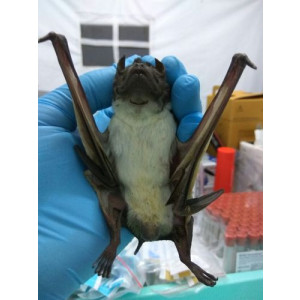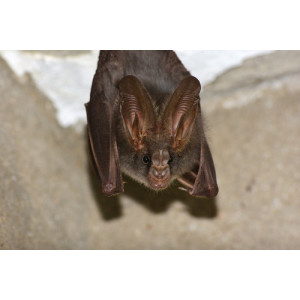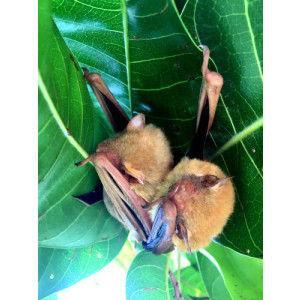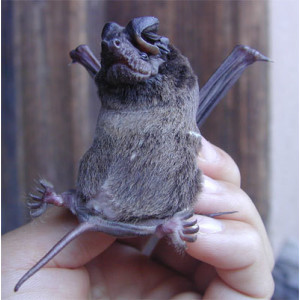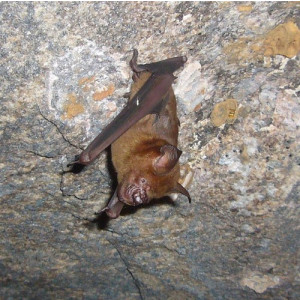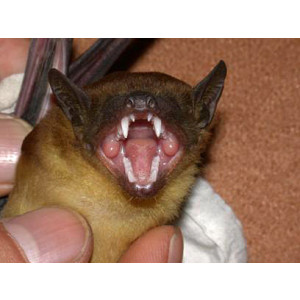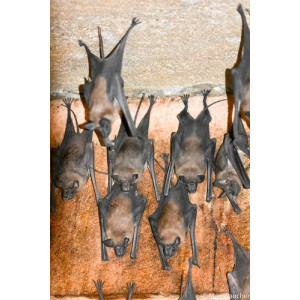Dawn Bat Did you see this animal?
Scientific Name : Eonycteris spelaea
Family : Pteropodidae
Order : Chiroptera
Class : Mammalia
Phylum : Chordata
Other Name : Common Dawn Bat, Common Nectar Bat, Lesser Dawn Bat
Habitat : Forest, Caves and Subterranean Habitats (non-aquatic)
Description : The dawn bat is a small bat with a wingspan of around 18-25 cm and a weight of 3-8 g. They have short, velvety fur that is usually brownish-grey on their back and lighter on their underside. Their face has a distinctive snub-nosed appearance, with large ears and dark eyes.
Dawn bats are found in a wide range of habitats, including woodlands, grasslands, and urban areas. They typically roost in small crevices or holes in trees, buildings, and other structures.
The dawn bat is a highly maneuverable flyer and can change direction quickly in flight. They have a fluttery, erratic flight pattern and can reach speeds of up to 40 km/hour.
The dawn bat is an insectivore, feeding on a variety of small flying insects such as moths, mosquitoes, and flies. They use echolocation to locate their prey and are particularly active at dusk and dawn.
The dawn bat has excellent hearing and vision. They have large ears that can detect a wide range of frequencies and can hear sounds that are beyond the range of human hearing. They also have good vision, although they are primarily nocturnal..
Dawn bats are social animals and are often found roosting in groups. They hibernate during the winter months, often in caves or other underground structures, and emerge in the spring to mate and feed. They are generally active from April to October.
Females typically give birth to a single offspring each year, usually in early summer. The young are born blind and hairless and are nursed by their mother for several weeks before becoming independent.
While dawn bats are generally sedentary and do not undertake long-distance migrations, they may move short distances in response to changes in food availability or other environmental factors.
Dawn bats are preyed upon by a variety of animals, including birds of prey, snakes, and other predators. They have several defense mechanisms, including their small size, agility in flight, and ability to roost in inaccessible locations.
The dawn bat is a common and widespread species and is not currently considered to be at risk of extinction. However, like many bat species, they face threats from habitat loss, disturbance of roosting sites, and the use of pesticides and other chemicals that reduce the availability of their insect prey.
In conclusion, the dawn bat is a small and agile bat species with a distinctive appearance and behavior. They are an important predator of insects and play a valuable role in maintaining the balance of ecosystems. While they are not currently endangered, efforts to protect their habitats and reduce threats to their populations are essential for their long-term survival.
Dawn bats are found in a wide range of habitats, including woodlands, grasslands, and urban areas. They typically roost in small crevices or holes in trees, buildings, and other structures.
The dawn bat is a highly maneuverable flyer and can change direction quickly in flight. They have a fluttery, erratic flight pattern and can reach speeds of up to 40 km/hour.
The dawn bat is an insectivore, feeding on a variety of small flying insects such as moths, mosquitoes, and flies. They use echolocation to locate their prey and are particularly active at dusk and dawn.
The dawn bat has excellent hearing and vision. They have large ears that can detect a wide range of frequencies and can hear sounds that are beyond the range of human hearing. They also have good vision, although they are primarily nocturnal..
Dawn bats are social animals and are often found roosting in groups. They hibernate during the winter months, often in caves or other underground structures, and emerge in the spring to mate and feed. They are generally active from April to October.
Females typically give birth to a single offspring each year, usually in early summer. The young are born blind and hairless and are nursed by their mother for several weeks before becoming independent.
While dawn bats are generally sedentary and do not undertake long-distance migrations, they may move short distances in response to changes in food availability or other environmental factors.
Dawn bats are preyed upon by a variety of animals, including birds of prey, snakes, and other predators. They have several defense mechanisms, including their small size, agility in flight, and ability to roost in inaccessible locations.
The dawn bat is a common and widespread species and is not currently considered to be at risk of extinction. However, like many bat species, they face threats from habitat loss, disturbance of roosting sites, and the use of pesticides and other chemicals that reduce the availability of their insect prey.
In conclusion, the dawn bat is a small and agile bat species with a distinctive appearance and behavior. They are an important predator of insects and play a valuable role in maintaining the balance of ecosystems. While they are not currently endangered, efforts to protect their habitats and reduce threats to their populations are essential for their long-term survival.
Distribution in Bangladesh
References:
description written by:Asad U. Tanvir,Department of Zoology,Jagannath University,Dhaka; reviewed by:Muntasir Akash,Department of Zoology,University of Dhaka;Taxonomic Checklist:Red List of Bangladesh Volume 2: Mammals, 2015, IUCN; information sources:Wikipedia , iucnredlist.org; photo credit:lenachow(www.inaturalist.org/people/lenachow), photo copyright: iNaturalist.more information please contact with us.
description written by:Asad U. Tanvir,Department of Zoology,Jagannath University,Dhaka; reviewed by:Muntasir Akash,Department of Zoology,University of Dhaka;Taxonomic Checklist:Red List of Bangladesh Volume 2: Mammals, 2015, IUCN; information sources:Wikipedia , iucnredlist.org; photo credit:lenachow(www.inaturalist.org/people/lenachow), photo copyright: iNaturalist.more information please contact with us.

